A roasting pan is the unsung hero of the kitchen, quietly mastering the art of cooking succulent roasts and savory dishes.
It’s not just a mere vessel but a culinary powerhouse, designed to handle high heat and distribute it evenly for perfectly cooked meals.
With its sturdy construction and spacious interior, a roasting pan transforms ordinary ingredients into extraordinary culinary delights, making it a must-have tool for any home chef aspiring to create memorable feasts.
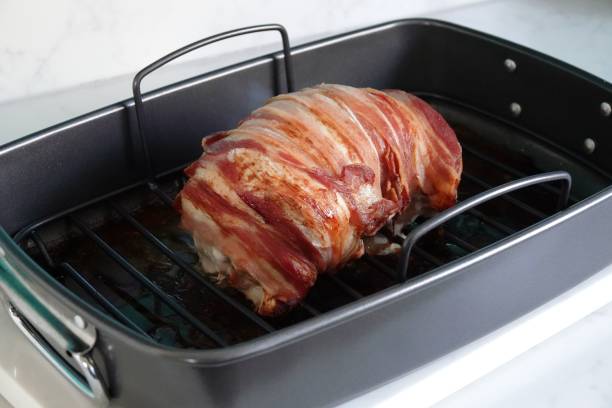
What Is A Roasting Pan
A roasting pan is a versatile kitchen essential designed specifically for roasting meats, vegetables, and other foods in the oven.
It typically features sturdy construction, with deep sides to contain juices and prevent splattering. The pan is often made of durable materials like stainless steel or heavy-gauge aluminum, providing even heat distribution for perfectly cooked dishes.
Roasting pans come in various sizes to accommodate different quantities of food, making them ideal for family dinners, holiday feasts, and special occasions.
They are commonly paired with roasting racks to elevate food and allow air circulation, promoting crispy exteriors and tender interiors.
Home cooks and professional chefs alike praise roasting pans for their ability to achieve delicious, succulent roasts with ease, making them a must-have tool in any kitchen arsenal.
Understanding Roasting
Definition of Roasting
Roasting is a cooking method that involves cooking food, usually meat or vegetables, in an oven or over an open flame. The process typically involves dry heat, which helps to brown the surface of the food, creating a flavorful crust while sealing in juices for moist and tender results.
Key Characteristics of Roasting
One of the key characteristics of roasting is the use of high heat, usually above 300°F (150°C), to cook the food evenly and develop a caramelized exterior.
This method is ideal for larger cuts of meat like roasts, whole poultry, and root vegetables, as it allows for slow and even cooking, resulting in tender and succulent dishes.
Roasting also enhances the natural flavors of the ingredients, making it a popular choice for showcasing the quality of the food being prepared.
Types of Foods Suitable for Roasting
- Meats: Roasting is particularly well-suited for meats such as beef, pork, lamb, and poultry. Whole cuts like ribeye roast, pork loin, leg of lamb, and whole chicken or turkey can be roasted to perfection, offering juicy and flavorful results.
- Vegetables: Root vegetables like potatoes, carrots, parsnips, and beets are excellent candidates for roasting. The dry heat of the oven caramelizes the natural sugars in the vegetables, resulting in a crispy exterior and a tender, flavorful interior.
- Fruits: Certain fruits like apples, pears, and stone fruits can also be roasted to bring out their natural sweetness and intensify their flavors. Roasted fruits can be served as a delicious dessert or paired with savory dishes for a unique flavor profile.
Roasting is a versatile cooking method that brings out the best in a wide range of ingredients, making it a favorite among home cooks and professional chefs alike.
Exploring the Roasting Pan
Definition of a Roasting Pan
A roasting pan is a specialized cooking vessel designed for roasting meats, poultry, vegetables, and other foods in the oven.
It typically features a rectangular or oval shape with low sides and may come with a removable rack that elevates the food from the bottom of the pan.
The purpose of a roasting pan is to allow hot air to circulate around the food evenly, promoting even cooking and browning.
Materials Used in Making Roasting Pans
Roasting pans are commonly made from various materials, each offering unique properties:
- Stainless Steel: Durable and easy to clean, stainless steel roasting pans are a popular choice for their longevity and resistance to corrosion. They distribute heat evenly, ensuring consistent cooking results.
- Aluminum: Lightweight and excellent at conducting heat, aluminum roasting pans heat up quickly and are often more affordable than stainless steel options. However, they may not be as durable.
- Non-Stick Coatings: Some roasting pans feature non-stick coatings, such as Teflon, to prevent food from sticking and make cleanup easier. These pans are ideal for roasting delicate foods that might otherwise adhere to the pan’s surface.
Size and Shape Variations of Roasting Pans:
Roasting pans come in various sizes and shapes to accommodate different cooking needs:
- Size: Roasting pans are available in small, medium, and large sizes, with capacities ranging from a few pounds to larger roasts that can feed a crowd. The size of the pan should match the amount of food being cooked to ensure proper heat circulation.
- Shape: While rectangular and oval shapes are common for roasting pans, there are also specialized shapes such as square or round pans designed for specific dishes. Some roasting pans may have deeper sides, which are suitable for cooking dishes with sauces or gravies.
Choosing the right roasting pan depends on factors like the type and quantity of food being cooked, preferred materials, and desired features such as a non-stick surface or a removable rack.
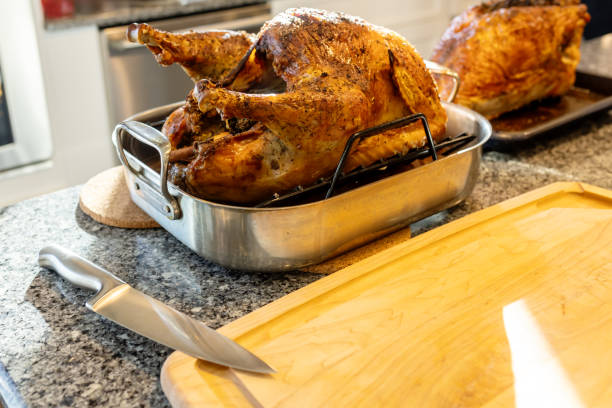
Components of a Roasting Pan
Main Body
The main body of a roasting pan is the central part that holds the food during the roasting process. It is typically made of durable materials like stainless steel, aluminum, or carbon steel, designed to withstand high oven temperatures without warping or bending.
The main body is often rectangular or oval-shaped with low sides to allow for easy access and even heat distribution around the food.
Handles
Roasting pans are equipped with handles for convenient handling and maneuvering in and out of the oven. These handles are usually made of heat-resistant materials like stainless steel or silicone to prevent burns when touching or lifting the pan.
Some roasting pans feature riveted handles for added durability, while others may have handles that fold down for compact storage.
Rack
Many roasting pans come with a removable rack that sits inside the main body. The rack serves several purposes:
- Elevates the Food: The rack lifts the food above the bottom of the pan, allowing hot air to circulate evenly around the food for uniform cooking and browning.
- Drip Pan: The space beneath the rack acts as a drip pan, collecting juices and fats released during cooking. This helps prevent the food from sitting in its own juices, resulting in crisper and more flavorful results.
- Easy Removal: When roasting is complete, the rack can be lifted out of the pan, making it easier to transfer the food to a serving platter or carving board without disrupting the cooking process.
The combination of the main body, handles, and rack makes a roasting pan a versatile and essential tool for cooking a variety of dishes, from succulent roasts to tender vegetables, with optimal results.
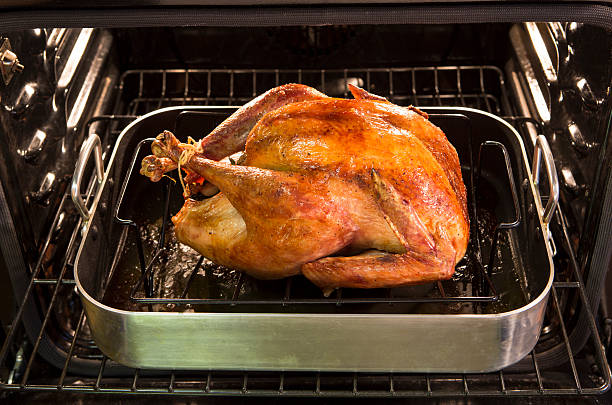
Functions of a Roasting Pan
Even Heat Distribution
One of the primary functions of a roasting pan is to ensure even heat distribution during the cooking process. The design of the pan, often with low sides and a spacious interior, allows hot air to circulate around the food uniformly.
This promotes consistent cooking and helps achieve a golden-brown crust on the exterior while keeping the interior moist and tender.
Collecting Drippings
Roasting pans are equipped with a rack that elevates the food, allowing juices and drippings to collect underneath. These flavorful drippings can be used to make gravies, sauces, or jus to enhance the flavor of the dish.
The pan’s design, with a drip tray or deep sides, helps contain the drippings and prevents them from spilling into the oven.
Ease of Handling and Serving
Another function of a roasting pan is to provide convenience in handling and serving the cooked food. The pan is equipped with sturdy handles, often heat-resistant, that make it easy to lift and maneuver the hot pan in and out of the oven.
Moreover, the removable rack allows for easy transfer of the food to a serving platter or carving board without disrupting its presentation or cooking process, making serving a breeze.
Types of Roasting Pans
Stainless Steel Roasting Pans
Stainless steel roasting pans are durable, corrosion-resistant, and ideal for high-heat cooking. They distribute heat evenly, ensuring consistent cooking results, and are easy to clean.
Stainless steel pans are often dishwasher-safe and can withstand repeated use without warping or deteriorating. They are a popular choice among home cooks and professional chefs for roasting meats, poultry, vegetables, and more.
Non-Stick Roasting Pans
Non-stick roasting pans feature a coating, such as Teflon or ceramic, that prevents food from sticking to the surface. These pans are easy to clean and require less oil or fat for cooking, making them a healthier option for roasting.
Non-stick roasting pans are suitable for delicate foods that are prone to sticking, such as fish fillets or tender vegetables. However, they may require gentle care to avoid scratching the non-stick coating.
Disposable Roasting Pans
Disposable roasting pans are made of aluminum or other materials and are designed for single-use or limited use. They are convenient for occasions where cleanup is a concern, such as parties, gatherings, or outdoor events.
Disposable pans eliminate the need for washing and can be recycled after use. While they may not offer the same durability as stainless steel or non-stick pans, disposable roasting pans are practical for certain cooking situations.
Each type of roasting pan has its advantages and is suited to different cooking preferences, budgets, and occasions. Users can choose the type that best fits their needs and culinary requirements.
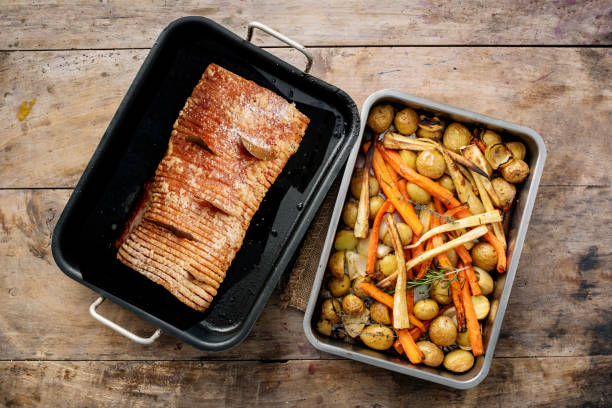
How to Choose the Right Roasting Pan
Consideration of Cooking Needs
When selecting a roasting pan, consider your cooking needs and the types of dishes you frequently prepare. If you often roast large cuts of meat or whole poultry, opt for a roasting pan with ample space and a sturdy rack to accommodate the size and weight of the food.
For versatile cooking, choose a pan that can also be used for roasting vegetables, fruits, and other dishes to maximize its utility.
Size and Capacity
The size and capacity of the roasting pan are crucial factors to consider. Ensure that the pan is large enough to hold the food comfortably without overcrowding, which can impede airflow and affect cooking results.
Consider the number of servings you typically cook and choose a pan with sufficient capacity to accommodate your needs. Moreover, check the dimensions to ensure the pan fits your oven without any issues.
Quality and Durability
Invest in a high-quality roasting pan that offers durability and longevity. Stainless steel and aluminum pans are known for their durability and resistance to warping, making them suitable for frequent use.
Look for pans with sturdy construction, reinforced handles, and a reliable rack that can support heavy roasts without bending or buckling. Consider pans with non-stick coatings for easier cleanup and maintenance, but ensure the coating is durable and safe for high-heat cooking.
Overall, choose a roasting pan that meets your cooking needs, has the right size and capacity for your dishes, and offers quality and durability to withstand regular use and deliver consistent cooking results.
Maintenance and Care of Roasting Pans
Cleaning Instructions
To ensure the longevity and optimal performance of your roasting pan, follow these cleaning instructions:
- After each use, allow the roasting pan to cool down before cleaning.
- If the pan has a non-stick coating, use a soft sponge or cloth and mild dish soap to clean it. Avoid using abrasive cleaners or scrubbers that can damage the non-stick surface.
- For stainless steel or aluminum pans, use a non-abrasive cleaner or a mixture of baking soda and water to remove any food residue or stains. Rinse thoroughly with water and dry with a clean towel.
- If there are stubborn stains or burnt-on food, soak the pan in warm, soapy water for a few hours before cleaning.
- Avoid using metal utensils or sharp objects that can scratch the surface of the pan, especially if it has a non-stick coating.
- For baked-on grease or residue, you can use a mixture of baking soda and water to create a paste and gently scrub the affected areas with a soft sponge or brush.
- Rinse the pan thoroughly after cleaning to remove any cleaning agents or residues.
- If the roasting pan is dishwasher-safe, you can place it in the dishwasher for easy cleaning. However, check the manufacturer’s instructions to ensure compatibility with your dishwasher.
- Store the roasting pan in a dry and well-ventilated area to prevent moisture buildup and potential rusting, especially for stainless steel pans.
By following these cleaning instructions and practicing proper maintenance, you can prolong the life of your roasting pan and ensure hygienic cooking experiences.
Storage Tips for Roasting Pans
- Ensure the roasting pan is completely dry before storing to prevent moisture buildup and potential rusting, especially for stainless steel pans.
- If the pan has a removable rack, store it separately to prevent it from scratching the surface of the pan and to maximize storage space.
- Consider using pan protectors or placing a soft cloth between stacked pans to prevent scratches and damage.
- Store the roasting pan in a cool, dry place away from direct heat sources or sunlight, which can affect the pan’s quality and appearance.
- If space allows, store the pan with its lid or cover to protect it from dust and debris.
- Avoid stacking heavy items on top of the roasting pan, as this can deform or damage the pan.
- Check the manufacturer’s instructions for any specific storage recommendations, especially for pans with non-stick coatings or special finishes.
- Periodically inspect the pan for any signs of wear, damage, or corrosion, and address any issues promptly to maintain its functionality and appearance.
By following these storage tips, you can keep your roasting pan in good condition and ready for use whenever you need it.
Longevity and Investment in Roasting Pans:
Investing in a high-quality roasting pan can lead to long-term benefits in terms of durability, performance, and cooking satisfaction. Here are some points to consider regarding longevity and investment in roasting pans:
- Durability: High-quality roasting pans, particularly those made from materials like stainless steel or aluminum with sturdy construction, are designed to withstand frequent use and maintain their functionality over time. They are less prone to warping, corrosion, or damage, ensuring reliable performance for years to come.
- Versatility: A durable and well-designed roasting pan can offer versatility in cooking, allowing you to roast a variety of foods such as meats, poultry, vegetables, and more. Look for pans with features like removable racks, non-stick coatings, and compatible designs for use on different heat sources (oven, stovetop, grill).
- Performance: A good roasting pan can enhance the flavor and texture of your dishes by promoting even heat distribution, collecting flavorful drippings for sauces and gravies, and facilitating easy handling and serving. Investing in a pan that delivers consistent cooking results can elevate your culinary skills and enjoyment.
- Cost-effectiveness: While high-quality roasting pans may have a higher initial cost compared to lower-quality or disposable options, they can prove to be cost-effective in the long run. Their durability means you won’t need to replace them frequently, saving you money over time.
- Cooking Experience: Using a well-made roasting pan can enhance your cooking experience by providing reliable performance, convenience in handling and cleaning, and the ability to achieve professional-level results. It can also inspire creativity in your cooking endeavors, allowing you to explore new recipes and techniques confidently.
Concisely, investing in a durable and versatile roasting pan can lead to long-term benefits in terms of durability, performance, cost-effectiveness, and overall cooking satisfaction. Choose a pan that suits your cooking needs, preferences, and budget to make the most out of your investment.
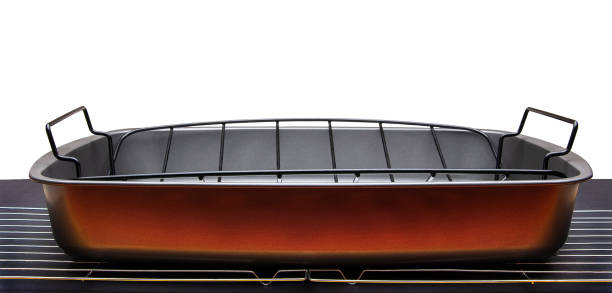
Creative Uses of Roasting Pans
Beyond Roasting Meats
- Roasting Vegetables: Use your roasting pan to roast a variety of vegetables, such as potatoes, carrots, Brussels sprouts, and squash. The spacious interior and even heat distribution help achieve caramelization and a flavorful char on the vegetables.
- Making One-Pan Meals: Create delicious one-pan meals by combining meats, vegetables, and seasonings in the roasting pan. Roast everything together for a convenient and flavorful dish with easy cleanup.
- Roasting Fruits: Experiment with roasting fruits like apples, pears, and peaches in the roasting pan. The heat caramelizes the natural sugars, enhancing the fruit’s sweetness and creating a delicious dessert or topping for yogurt and ice cream.
Baking and Casseroles
- Baking Bread: Use your roasting pan as a makeshift baking dish for artisanal bread or focaccia. The pan’s shape and size provide ample space for dough to rise and bake into a crusty, golden loaf.
- Making Casseroles: Prepare savory casseroles, such as lasagna, baked pasta dishes, or gratins, in the roasting pan. The depth of the pan allows for layering ingredients and baking them to perfection with a crispy top.
Serving and Presentation
- Buffet Serving: Use the roasting pan as a stylish and practical serving dish for buffet-style gatherings. It can hold a large quantity of food and keep it warm with a lid or cover.
- Rustic Presentation: Serve roasted meats and vegetables directly in the roasting pan for a rustic and inviting presentation. Garnish with fresh herbs and seasonings for an appetizing display.
- Chilled Desserts: Chill desserts like cheesecake or tiramisu in the roasting pan for a uniform and elegant presentation. The pan’s size is ideal for setting up a dessert bar at parties or events.
By thinking outside the box and exploring the versatility of your roasting pan, you can discover creative ways to enhance your cooking and presentation skills while making the most of this essential kitchen tool.
Roasting Pan Tips and Tricks
- Preheat the Pan: Preheat your roasting pan in the oven before adding the food. This helps to ensure even cooking and browning, especially for meats and vegetables.
- Use a Rack: If your roasting pan comes with a rack, use it to elevate the food from the bottom of the pan. This allows hot air to circulate around the food, promoting even cooking and preventing soggy bottoms.
- Add Liquid: For moist and flavorful results, add a liquid such as broth, wine, or water to the bottom of the roasting pan. This helps to create steam, keeping the food juicy and enhancing its flavor.
- Season Generously: Season the food liberally with herbs, spices, and seasoning blends before roasting. This adds depth of flavor and enhances the overall taste of the dish.
- Baste Regularly: If roasting meats, baste them regularly with pan juices or a marinade to keep them moist and tender. Use a basting brush or spoon to coat the meat evenly.
- Monitor Temperature: Use a meat thermometer to monitor the internal temperature of roasts and poultry. This ensures that the food is cooked to the desired level of doneness and eliminates guesswork.
- Rest Before Carving: Allow roasted meats to rest for a few minutes before carving. This allows the juices to redistribute, resulting in juicier and more tender slices.
- Use Foil Tenting: If the top of the food is browning too quickly, tent the roasting pan with aluminum foil to prevent over-browning while allowing the food to continue cooking.
- Deglaze the Pan: After roasting, use the pan drippings to make a flavorful sauce or gravy. Deglaze the pan with broth, wine, or water, and then simmer and reduce the liquid to create a delicious sauce.
- Easy Cleanup: Line the roasting pan with aluminum foil or parchment paper before adding the food for easy cleanup. This reduces the need for scrubbing and soaking after cooking.
By incorporating these tips and tricks, you can maximize the performance of your roasting pan and create delicious, perfectly roasted dishes with ease.
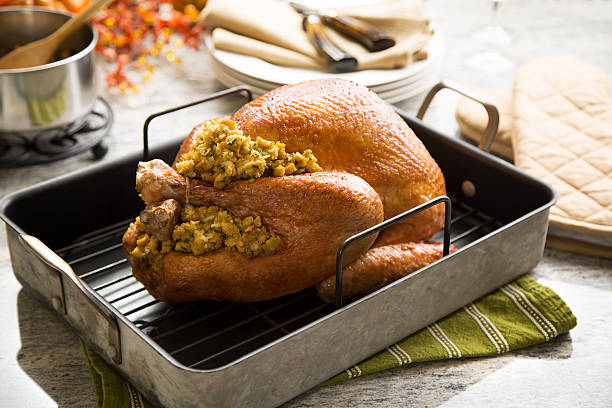
Frequently Asked Questions (FAQs) – What Is A Roasting Pan
Q: What is a roasting pan, and why is it essential for cooking?
A: A roasting pan is a versatile kitchen tool designed for roasting meats and vegetables to perfection. Its deep sides and sturdy construction ensure even heat distribution and help retain juices for flavorful results.
Q: What are the benefits of using a roasting pan?
A: Using a roasting pan enhances the cooking experience by promoting even cooking, crispy exteriors, and juicy interiors. It also makes cleanup a breeze with its non-stick or easy-to-clean surfaces.
Q: How does a roasting pan contribute to delicious meals?
A: A roasting pan’s design allows for optimal air circulation, resulting in dishes that are beautifully browned on the outside and tender on the inside. This enhances the flavors and textures of your favorite recipes.
Q: Can a roasting pan be used for more than just roasting?
A: Absolutely! A roasting pan is a versatile tool that can also be used for baking, broiling, and even serving dishes straight from the oven to the table, making it a must-have for any home chef.
Q: What features should I look for in a quality roasting pan?
A: Look for a roasting pan with sturdy handles for easy handling, a non-stick or easy-to-clean surface for effortless cleanup, and a size that suits your cooking needs, whether you’re roasting a small chicken or a holiday turkey.
Q: How does using a roasting pan elevate my cooking skills?
A: By providing a reliable and efficient cooking vessel, a roasting pan empowers you to create restaurant-quality dishes at home, impressing family and friends with your culinary prowess.
Q: Can a roasting pan help me save time in the kitchen?
A: Absolutely! The efficient design of a roasting pan ensures that your meals cook evenly and retain moisture, reducing cooking times and allowing you to focus on other aspects of meal preparation.
Q: What are some creative ways to use a roasting pan beyond traditional roasting?
A: Aside from roasting meats and vegetables, a roasting pan can be used for baking casseroles, lasagnas, and even desserts like brownies or cobblers, adding versatility to your kitchen repertoire.
Q: Is a roasting pan a worthwhile investment for my kitchen?
A: Absolutely! A quality roasting pan is a long-lasting investment that will enhance your cooking experience, inspire creativity in the kitchen, and help you achieve delicious, professional-looking results every time.
Q: How can I care for and maintain my roasting pan to ensure longevity?
A: To prolong the life of your roasting pan, hand wash with mild soap and warm water, avoid using abrasive cleaners or utensils, and store it properly to prevent damage. With proper care, your roasting pan will serve you well for years to come.
Conclusion
In conclusion, a roasting pan is a versatile and essential tool in the kitchen, especially for cooking large cuts of meat or poultry.
Its sturdy construction, with high sides and a rack for elevating the food, allows for even cooking and optimal browning. Whether you’re preparing a holiday feast or a weeknight dinner, a quality roasting pan can help you achieve delicious results every time.
Its functionality extends beyond roasting, as it can also be used for baking, broiling, and even serving. Investing in a good roasting pan can elevate your cooking experience and open up a world of culinary possibilities.
Other Articles You May Also Like:
- What Is A Loaf Pan (8 Cool Facts To Know)
- What Is A Muffin pan (9 Eye-Opening Things To know)
- What Is A Dutch Oven (8 Cool Facts To Know)
- What Is A Hotel Pan (6 Cool Facts You Need To Know)
- What Is PFOA? (7 Cool Facts To Know)
- What Is A Tart Pan (3 Surprising Facts)
- What Is A Broiler Pan (4 Secret Things)
- What Is A Tube Pan – Tube Pan Vs Bundt Pan